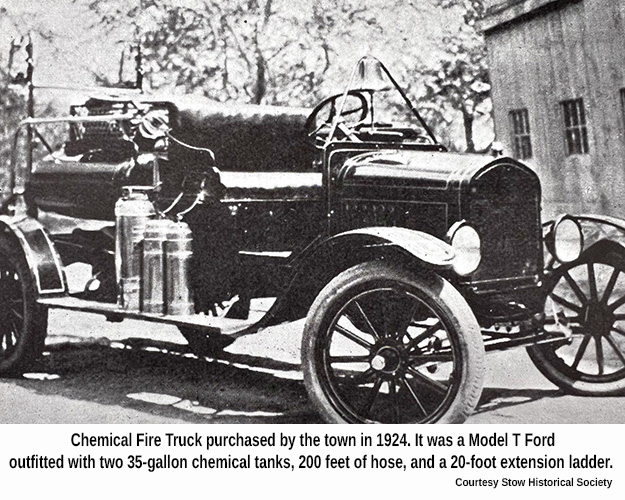
“For Safety’s Sake”
By Stephanie Lewis
An interesting feature of many small towns around Massachusetts is that they have a volunteer fire department or had one at some point. Stow is no exception.
Small town fire departments did not usually begin with a full-time paid staff. They grew over the years, often starting by engaging a few volunteers to watch over the town. This is how Stow’s story begins.
In the early 1900s, Stow allocated money to purchase 50 soda-acid extinguishers to be held around town by 10 men who agreed to respond to all fires. These were put to good use in 1915 when Ralph Stiles’s house at 32 Maple Street was destroyed by fire. While the house was a total loss, firefighter Edward Wheeler was able to save the attached barn by using these extinguishers as they were passed to him through the barn window. He was considered the town hero that day, though he did singe off his eyebrows and eyelashes, according to Francis Warren’s memory.
The extinguishers would come in handy again when Harold Everett’s barn at 106 West Acton Road, now Shelbourne Farm, caught fire from the spontaneous combustion of green hay. The extinguishers and the town sprayer for roadside trees were employed to keep the house from burning; however, the barn was destroyed.
The extinguishers were not a perfect solution, so in 1924 the town purchased, at the request of town fire wardens Henry Warren, Herbert Underwood, and John Wetherbee, a Model T Ford to be outfitted with two 35-gallon chemical tanks, 200 feet of hose, and a 20-foot extension ladder.
In 1929, the Model T was traded in for a proper fire truck–a Reo. It had a Fitzhenry Guptill pump with 2000 feet of hose and 50 feet of suction hose, a Siamese coupling, and two nozzles. The chemical tanks from the Ford were moved to the new truck and they had “a steel body made to carry the hose, pump, and 11 two-and-one-half-gallon extinguishers, a 36-foot extension ladder, and an 18-foot roof ladder, plaster hook, axe, bar, and shovels,” according to the 1929 Stow Town Report. In 1930, a 500-gallon-per-minute Barton Pump was installed on the front of the Reo.
All through this time there were volunteers who would respond to fires around town, but it was not until 1933 that a proper volunteer firefighter company was formed. John Wetherbee, who had been a fire warden since 1917, was named the first Fire Chief and he remained in that position until his retirement in 1941. Harold Priest then became Chief. By the end of the war, James Lund, Jr., was the new Fire Chief and there were 35 volunteer firemen and a proper fire station.
In the early days, fire alerts were through the ringing of the church bells. When telephones came to town, they were employed. In 1938, a fire whistle was installed in the Town Hall. It not only alerted the volunteer squad that there was a fire, but it rang out in a code that led those firefighters to the general area of the blaze, as each section of town had its own signal. Today, modern technology is employed, and the loud siren is no more.
